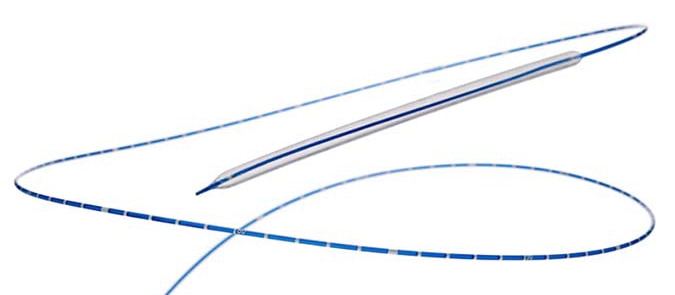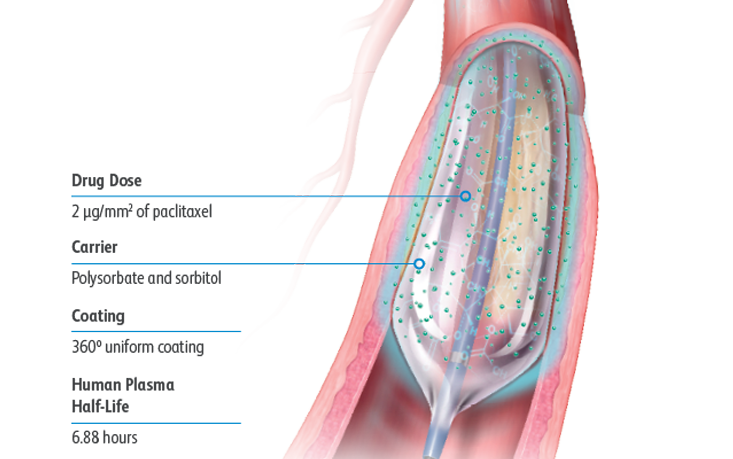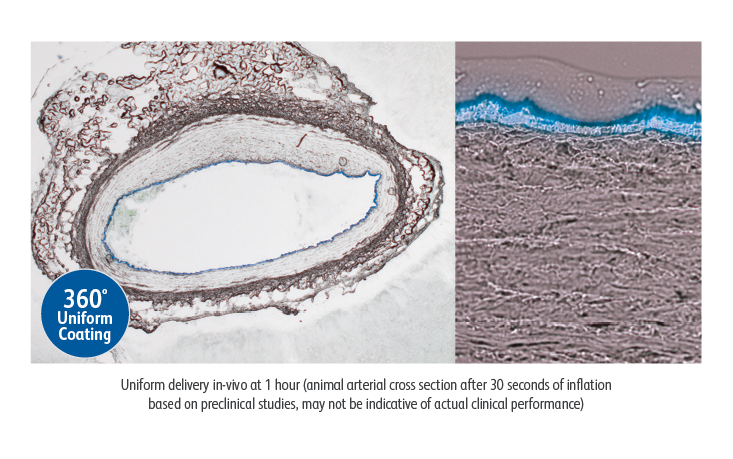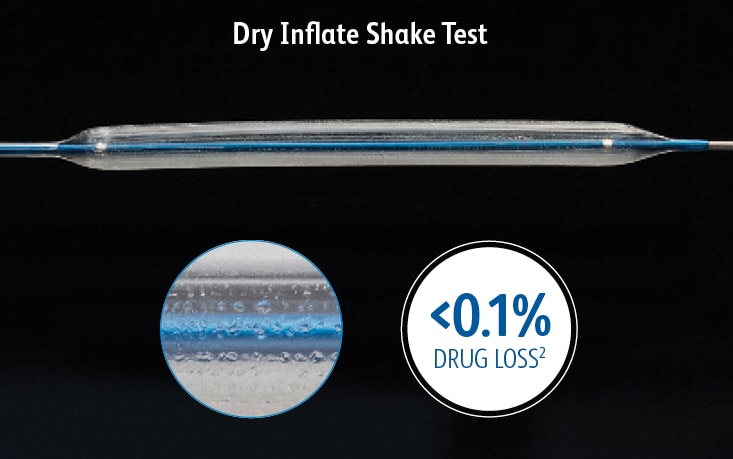

- Overview
- Features
- Clinical Data
- Competitive Overview
- Products & Accessories
- EIFU & Resources
The Lutonix™ Drug Coated Balloon PTA Catheter is offered in 0.018 and 0.035 guidewire configurations for the treatment of de novo, restenotic, or in-stent restenotic lesions in the superficial femoral and popliteal arteries. The Lutonix™ DCB delivers a dose of 2 µg/mm2 of paclitaxel and is designed to provide the versatility needed to treat lesions of varying sizes and lengths. It is engineered to enhance femoropopliteal procedures by providing:
- A robust size matrix
- Extensive indications
- Proven results in a Level 1 Clinical Trial1

The GeoAlign™ Marking System is a standardized non-radiopaque ruler on the catheter shaft designed to:
- Facilitate repeat catheter placement
- Increase procedural efficiency
1 LEVANT 2 clinical trial data on file. N=476. At 12 months, treatment with Lutonix™ 035 resulted in a primary patency rate of 73.5% versus 56.8% with PTA alone (p=0.001). Primary patency defined as absence of binary restenosis defined by DUS PSVR ≥ 2.5 and freedom from Target Lesion Revascularization (TLR). At 12 months, treatment with Lutonix™ 035 DCB resulted in a freedom from primary safety event rate of 86.8% versus 81.9% with PTA alone (p=0.185). Primary safety defined as composite of freedom from all-cause perioperative death and freedom at 1 year in the index limb from Amputation (ATK or BTK), Reintervention, and Index-limb related death. Numbers reported are Kaplan-Meier analyses, not pre-specified.
2 As of June 2024. 300 mm only available on select 0.018 guidewire sizes.
3 GeoAlign™ Markers are not a replacement for fluoroscopy. When the catheter is exposed to the vascular system, the location of the balloon should be confirmed while under high quality fluoroscopic observation. Animal study (repeat PTA in swine artery) was performed by 3 physicians who tested the Lutonix™ 035 DCB (no drug) and the Ultraverse™ 035 PTA Catheter, both with GeoAlign™ Markers, to POBA with no GeoAlign™ Markers (n=112, test n = 96, control n = 16). Animal data on file. BD Animal test results may not be indicative of clinical performance. Different test methods may yield different results.
Please consult Instructions for Use for product indications for use, contraindications, warnings, precautions, complications, adverse events and detailed safety information. ℞ only
BD-38946v3

The Lutonix™ DCB formulation was designed for the optimal balance of safety and efficacy with a dose of 2 μg/mm2 and polysorbate and sorbitol excipients, which together allow for an effective transfer of drug to the vessel wall.

The Lutonix™ 035 DCB demonstrated a consistent coating resulting in:
- 360° of paclitaxel coating at the target vessel1
- ~6.46 μm coating thickness1

The Lutonix™ DCB coating formulation is designed to:
- Ensure rapid uptake of the drug to the vessel wall during inflation
- Provide uniform delivery of the drug to the vessel wall
- Help minimize unnecessary drug exposure to staff and patients
In a dry inflate shake test, the Lutonix™ 035 DCB showed a <0.1% drug loss2
Data from a Pre-Clinical Animal Study showed Lutonix™ DCB had desired pharmacologic levels with biologic effects without evidence of significant downstream emboli or systemic toxicity.3
1 Bench test and pre-clinical animal study data on file. Bench test results and preclinical data may not be indicative of clinical performance. Different test methods may yield different results.
2 Dry Inflate/Shake Bench Test data on file, BD, Tempe AZ. Shake test measured the average drug content lost after balloon was inflated, and after lightly knocking the device against the sides of a centrifuge tube, left and right, five times. n=5. Bench test results may not be indicative of clinical performance. Different test methods may yield different results.
3 Virmani Pre-Clinical Animal Data GLP Study. Pre-clinical data on file. Pre-clinical results may not be indicative of clinical performance. Different test methods may yield different results.
Please consult Instructions for Use for product indications for use, contraindications, warnings, precautions, complications, adverse events and detailed safety information. ℞ only
BD-38946v3
The Lutonix Global Registry showed sustained effectiveness of Lutonix™ 035 DCB in heterogeneous patient population in real-world clinical practice.1
The primary effectiveness endpoint was defined as Kaplan-Meier (K-M) freedom from Target Lesion Revascularization at 12 months and measured at 94.1%. At 24 months, the Kaplan-Meier (K-M) Freedom from Target Lesion Revascularization was 90.3%.1
At 24 months, the Lutonix™ 035 DCB maintained effectiveness in long lesions and in-stent restenosis subgroups with a Freedom from Target Lesion Revascularization of 88.2% and 84.6%, respectively. 1
The LEVANT 2 pivotal study is a global, prospective, single-blind, randomized, 54-site study (42 sites in the United States and 12 in Europe) that enrolled all patients under one protocol, comparing the Lutonix™ 035 DCB with standard PTA.2
The study met its primary endpoints for safety and efficacy.
- Safety: Lutonix™ 035 demonstrated a safety profile that is consistent with PTA
- Efficacy: Lutonix™ 035 demonstrated a 29.4% better primary patency rate at 12 months than PTA
1 Lutonix Global SFA Real-World Registry, n=691. The primary safety endpoint was freedom from target vessel reintervention, major index limb amputation, and device- or procedure related death at 30 days. Freedom from primary safety events at 30 days was 99.4% (681/681). Primary effectiveness endpoint is defined as freedom from TLR at 12 months. TLR-Free rate by subject counts at 12 months was 93.4% (605/648). The Kaplan-Meier TLR-Free survival estimate was 94.1%. Long lesions were defined as any lesion >= 140 mm. All subjects treated with the Lutonix™ 035 DCB. In the LEVANT 2 IDE Clinical Trial, treatment with Lutonix™ 035 DCB resulted in freedom from TLR rate of 87.7% at 12 months (250/285) and a freedom from TLR rate of 82.0% at 24 months. Data on file, Becton, Dickinson and Company.
2 LEVANT 2 clinical trial data on file. N=476. At 12 months, treatment with Lutonix™ 035 resulted in a primary patency rate of 73.9% versus 57.8% with PTA alone (p=0.001). Primary patency defined as absence of binary restenosis defined by DUS PSVR ≥ 2.5 and freedom from Target Lesion Revascularization (TLR). At 12 months, treatment with Lutonix™ 035 DCB resulted in a freedom from primary safety event rate of 86.8% versus 81.9% with PTA alone (p=0.185). Primary safety defined as composite of freedom from all-cause peri-operative (<= 30 day) death and freedom at 1 year in the index limb from Amputation (ATK or BTK), Reintervention, and Index-limb related death. Numbers reported are Kaplan-Meier analyses, not pre-specified.
Please consult Instructions for Use for product indications for use, contraindications, warnings, precautions, complications, adverse events and detailed safety information. ℞ only
BD-38946v3
Lutonix™ DCB's coating was determined through extensive development and testing. Over 50,000 balloons and 250 formulations were tested before the final optimized formulation was chosen.
Devices were magnified at similar settings and frame of view
Lutonix™ 035 DCB showed lower downstream paclitaxel concentrations compared to Medtronic In.Pact™ DCB in a pre-clinical study.
Lutonix™ DCB is the only DCB on the U.S. market long enough to treat lesions up to 300 mm in length with a single balloon.3 It is designed to reduce acquisition costs associated with using two competitive DCBs.
Through the BD reintervention-free warranty program, a no-charge replacement code will be sent to your account if a patient returns for a reintervention of the original target lesion within 24 months of initial Lutonix™ DCB treatment. 5
1 November 2016. Journal of Vascular and Interventional Radiology: Comparison of Particulate Embolization after Femoral Artery Treatment with IN.PACT Admiral versus Lutonix 035 Paclitaxel-Coated Balloons In Healthy Swine. Limitations associated with this pre-clinical study include: Pathologic findings are limited to healthy swine and do not account for the fact that human PAD presents with co-morbidities; and transferring pre-clinical findings in healthy animal arteries to humans with peripheral arterial disease is complex, as lesions can be complicated fibrosis, necrosis and calcification. Data presented as median (interquartile range). This study was funded by Lutonix, Inc. Article available at: "https://www.jvir.org/article/S1051-0443(16)30338-4/pdf"
2 Pre-Clinical head-to-head comparison of vascular changes (inflammation, smooth muscle cell necrosis, fibrinoid necrosis, nuclear pykosis). 3x balloons. 1 minute inflation. Data presented are median (interquartile range). Pre-clinical safety comparison study of and downstream paclitaxel level of treatment with different Drug Coated Balloon Catheters in a swine femoral model and may not be indicative of clinical performance. Data on file, Bard Peripheral Vascular, Inc. March 2017.
3 As of June 2024.
4 Estimated DCB acquisition cost savings based on average selling price data from IQVIA reported for Q3 2022. Average selling price for 300 mm Lutonix™ DCB ($1,445) compared to the blended average selling price for 2 150 mm DCBs from the following competitors: In.Pact™ DCB ($1,556), Ranger™ DCB ($1,589), and Stellarex™ DCB ($1,467). Data on file. BD. Tempe, AZ
5 BD reserves the right to terminate this program at any time. Please note, signed Lutonix™ DCB Reintervention Free Warranty Purchase Agreement terms and conditions apply.
6 Kaplan-Meier. Lutonix Global SFA Real World Registry, n=691. Primary efficacy endpoint is defined as freedom from TLR at 12 months. TLR Free rate by subject counts at 12 months was 93.4% (605/648). The Kaplan-Meier TLR-Free survival estimate was 94.1% at 12 months and 90.3% at 24 months. Lutonix Global SFA Real-World Registry long lesion cohort was defined as lesions =140mm, and had a freedom from composite safety rate of 76.7% at 24 months. In the LEVANT 2 IDE Clinical Trial, treatment with Lutonix™ 035 DCB resulted in freedom from TLR rate of 87.7% at 12 months (250/285). Data on file. BD Peripheral Intervention, Tempe, AZ.
Please consult Instructions for Use for product indications for use, contraindications, warnings, precautions, complications, adverse events and detailed safety information. ℞ only
BD-38946v3
Please consult Instructions for Use for product indications for use, contraindications, warnings, precautions, complications, adverse events and detailed safety information. ℞ only
BD-38946
Our collection of literature on industries and on our offerings gives you information you can use to continue striving for excellence.
We support the healthcare industry with market-leading products and services that aim to improve care while lowering costs. We host and take part in events that excel in advancing the world of health™.
The BD Learning Academy offers a centralized repository of BD product training, education, and the ability to connect courses to your LMS.
We promote clinical excellence by providing various resources on best practices, clinical innovations and industry trends in healthcare.
Please consult Instructions for Use for product indications for use, contraindications, warnings, precautions, complications, adverse events and detailed safety information. ℞ only
BD-38946